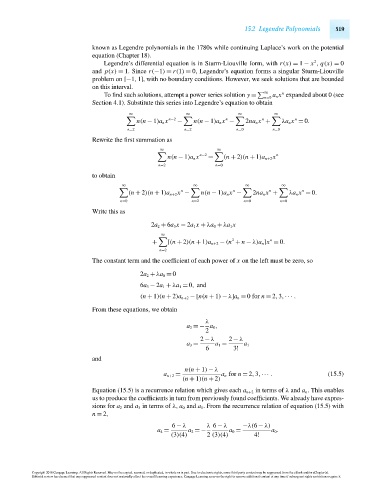Page 539 - Advanced_Engineering_Mathematics o'neil
P. 539
15.2 Legendre Polynomials 519
known as Legendre polynomials in the 1780s while continuing Laplace’s work on the potential
equation (Chapter 18).
2
Legendre’s differential equation is in Sturm-Liouville form, with r(x) = 1 − x , q(x) = 0
and p(x) = 1. Since r(−1) = r(1) = 0, Legendre’s equation forms a singular Sturm-Liouville
problem on [−1,1], with no boundary conditions. However, we seek solutions that are bounded
on this interval.
∞ n
To find such solutions, attempt a power series solution y = a n x expanded about 0 (see
n=0
Section 4.1). Substitute this series into Legendre’s equation to obtain
∞ ∞ ∞ ∞
n
n
n
n(n − 1)a n x n−2 − n(n − 1)a n x − 2na n x + λa n x = 0.
n=2 n=2 n=0 n=0
Rewrite the first summation as
∞ ∞
n−2 n
n(n − 1)a n x = (n + 2)(n + 1)a n+2 x
n=2 n=0
to obtain
∞ ∞ ∞ ∞
n n n n
(n + 2)(n + 1)a n+2 x − n(n − 1)a n x − 2na n x + λa n x = 0.
n=0 n=2 n=0 n=0
Write this as
2a 2 + 6a 3 x − 2a 1 x + λa 0 + λa 1 x
∞
2
n
+ [(n + 2)(n + 1)a n+2 − (n + n − λ)a n ]x = 0.
n=2
The constant term and the coefficient of each power of x on the left must be zero, so
2a 2 + λa 0 = 0
6a 3 − 2a 1 + λa 1 = 0, and
(n + 1)(n + 2)a n+2 −[n(n + 1) − λ]a n = 0for n = 2,3,··· .
From these equations, we obtain
λ
a 2 =− a 0 ,
2
2 − λ 2 − λ
a 3 = a 1 = a 1
6 3!
and
n(n + 1) − λ
a n+2 = a n for n = 2,3,··· . (15.5)
(n + 1)(n + 2)
Equation (15.5) is a recurrence relation which gives each a n+2 in terms of λ and a n . This enables
us to produce the coefficients in turn from previously found coefficients. We already have expres-
sions for a 2 and a 3 in terms of λ, a 0 and a 1 . From the recurrence relation of equation (15.5) with
n = 2,
6 − λ λ 6 − λ −λ(6 − λ)
a 4 = a 2 =− a 0 = a 0 .
(3)(4) 2 (3)(4) 4!
Copyright 2010 Cengage Learning. All Rights Reserved. May not be copied, scanned, or duplicated, in whole or in part. Due to electronic rights, some third party content may be suppressed from the eBook and/or eChapter(s).
Editorial review has deemed that any suppressed content does not materially affect the overall learning experience. Cengage Learning reserves the right to remove additional content at any time if subsequent rights restrictions require it.
October 14, 2010 15:20 THM/NEIL Page-519 27410_15_ch15_p505-562

